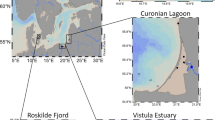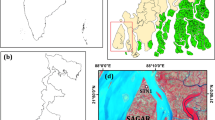Abstract
Two Red Sea coastal inlets situated on the Saudi Arabian western coast were visited 7 years after the implementation of a rehabilitation program including the official cessation of wastewater discharge, dredging of bottom sludge, and deployment of 28 air pumps to enhance water mixing and aeration. Visual observations indicated the presence of active sewage disposal points and apparent eutrophication. Chemical analysis of surface water supported this observation by providing measurable evidences, such as salinity lowering to about 30 and decrease of pH near the active effluents. Moreover, the extremely high concentrations of inorganic nitrogen (95 % as ammonium), phosphorus, and dissolved organic carbon are comparable to concentrations measured before the implementation of the program. Based on the apparent conservative behavior of phosphate, inorganic nitrogen, and dissolved organic carbon, concentrations of these variables at zero salinity were calculated and their budgets were estimated and compared with the measured quantities present in the surface mixed layer. The role of nitrogen and phosphorus as limiting elements was investigated using the nitrogen and phosphate ratio and the correlative plot of total inorganic nitrogen and phosphate against salinity. The pollution load, calculated using concentrations at zero salinity and nominal hydraulic flow of the effluents, amounted to 2,737 and 285 kg/day of inorganic nitrogen and phosphorus, respectively. Potential algal mass production that may result from the total assimilation of this nutrient influx is equivalent to 23–30 tons/day, which is several times higher than the direct organic matter input from the sewage effluents.








Similar content being viewed by others
References
Abu-Zied RH, Basaham AS, El Sayed MA (2012) Effect of municipal wastewaters on bottom sediment geochemistry and benthic foraminifera of two Red Sea coastal inlets, Jeddah, Saudi Arabia. Environ Earth Sci. doi:10.1007/s12665-012-1751-7
Al Farawati RK, El Maradny A, Basaham AS, El Sayed MA (2008) Reclaimed municipal wastewater used for the irrigation of green areas in Jeddah: 1-chemical characteristics. J KAU Mar Sci 19:121–146
Aminot A, Kérouel R (2004a) Hydrologie des écosystèmes marins: paramètres et analyses. IFREMER, Brest
Aminot A, Kérouel R (2004b) Dissolved organic carbon, nitrogen and phosphorus in the N-E Atlantic and the N-W Mediterranean with particular reference to non-refractory fractions and degradation. Deep-Sea Res I 51:1975–1999
Aminot A, El Sayed MA, Kérouel R (1990a) Fate of natural and anthropogenic dissolved organic carbon in the macrotidal Elorn estuary. Mar Chem 29:255–275
Aminot A, Guillaud JF, Le Guellec AM (1990b) Suivi à long terme des apports des matières organiques et nutritives par les effluents de Morlaix: Rapport IFREMER; DERO. 90-30. Brest, France
Bethoux JP, Morin P, Ruiz-Pino DP (2002) Temporal trends in nutrient ratios: chemical evidence of Mediterranean ecosystem changes driven by human activity. Deep-Sea Res II 49:2007–2016
Biggs RB, Cronin LE (1981) Special characteristics of estuaries. In: Neilson BJ, Cronin LE (eds) Estuaries and nutrients. Humana Press, Clifton, pp 3–23
Cadée GC (1982) Tidal and seasonal variation of particulate and dissolved organic carbon in the western Dutch Wadden Sea and Marsdiep tidal inlet. Neth J Sea Res 15:228–249
Carlson RE (1977) A trophic state index for lakes. Limnol Oceanogr 22:361–369
Carlson RE, Simpson J (1996) A Coordinator’s Guide to volunteer lake monitoring methods. North American Lake Management Society, pp 96
Duce RA, Duursma EK (1977) Inputs of organic matter to the ocean. Mar Chem 5:319–339
Edwards AJ, Head SM (1987) Key environments-Red Sea. Pergamon Press, Oxford
El Rayis OA (1998) Environmental conditions of two Red Sea coastal inlets in Jeddah. 2, nutrients. J KAU Mar Sci 9:49–59
El Rayis OA, Moammar MO (1998) Environmental conditions of two Red Sea coastal inlets in Jeddah. 1, Hydrochemistry. J KAU Mar Sci 9:31–47
El Sayed MA (1988) Contribution to the study of the geochemical behavior of some trace elements (Cu, Fe, Mn and Zn) and organic matter in the estuarine environment: case of the Loire estuary and the Rade of Brest. Dissertation, University of West Brittany, Brest (in French)
El Sayed MA (2002a) Distribution and behavior of the dissolved species of nitrogen and phosphorus in two coastal Red Sea inlets receiving domestic sewage. J KAU Mar Sci 13:47–73
El Sayed MA (2002b) Nitrogen and phosphorus in the effluent of a sewage treatment station on the eastern Red Sea coast: daily cycle, flux and impact o the coastal area. Int J Environ Stud 59:73–94
El Sayed MA, Basaham AS, Rifaat AE, Niaz GR, Al Farawati RKh, El Mamoney MH (2004) Sewage pollution in the coastal area south of Jeddah: The problem revisited. King Abdulaziz University, SRC, Jeddah
EPA (2010) Guidance specifying management measures for sources of nonpoint pollution in coastal waters. Chapter 8: monitoring and tracking techniques to accompany management measures: techniques for assessing water quality and for estimating pollution loads. http://www.epa.gov/owow/NPS/MMGI/Chapter8/ch8-2.html. Accessed 18 June 2012
Gazaz MO (2007) Distribution phosphorus and nitrogen species and some trace elements in the coastal waters of eastern red Sea. Dissertation, King Abdulaziz University, Jeddah
Global Water Intelligence (2007) Jeddah outlines wastewater BOTs. http://www.globalwaterintel.com/archive/8/8/general/jeddah-outlines-wastewater-bots.html
Håkanson L (1994) A review of effect-dose-sensitivity models for aquatic ecosystems. Int Rev Hydrobiol 79:621–667
Häse C, Qutob M, Dubinsky Z, Ibrahim EA, Laza B, Stamber N, Tilzer MM (2006) A system in balance? Implications of deep vertical mixing for the nitrogen budget in the northern Red Sea, including the Gulf of Aqaba (Eilat). Biogeosci Discuss 3:383–408
Howarth RW (1988) Nutrient limitation of net primary production in marine ecosystems. Annu Rev Ecol 19:89–110
Imberger J, Berman T, Christian RR, Sherr EB, Whitney DE, Pomeroy LR, Wiegert RG, Wiebe WJ (1983) The influence of water motion on the distribution and transport of materials in a salt marsh estuary. Limnol Oceanogr 28:201–214
Justic D, Rabalais NN, Turner RE, Dortch Q (1995) Changes in nutrient structure in river-dominated coastal waters: stoichiometric nutrient balance and its consequences. Estuar Coast Shelf Sci 40:339–356
Karbe L, Lange J (1981) The chemical environment. In: Karbe L, Theil H, Weikert H, Mill A JB (ed) Mining of metalliferous sediments from the Atlantis II deep, Red Sea: pre-mining environment conditions and evaluation of the risk to the environment. Environmental impact study presented to Saudi-Sudanese Red Sea Joint Commission, Jeddah. Hambourg
Kotb MA, Hanafy MH, Rirache H, Matsumura S, Al-Soufyani AA, Ahmed AG, Bawazir G, Al-Horani FA (2008) In: Wilkinson C (ed) Status of coral reefs of the world: 2008. Global coral reef monitoring network and reef and rainforest research Center, Townsville, pp 67–74
Krom Md, Brenner S, Kress N, Gordon LI (1991) Phosphorus limitation of primary productivity in the Eastern Mediterranean Sea. Limnol Oceanogr 36:424–432
Lane R, Day JW, Justic D, Reyes E, Max B, Day JN, Hyfield E (2004) Changes in stoichiometric Si, N and P ratios of Mississipi River water diverted though coastal wetlands to the Gulf of Mexico. Estuar Coast Shelf Sci 60:1–10
Mantoura RFC, Woodward EMS (1983) Conservative behavior of riverine dissolved organic carbon in Severn estuary: chemical and geochemical implications. Geochim Cosmochim Acta 47:1293–1309
Mooper K, Degens ET (1979) Organic carbon in the ocean: nature and cycling. In: Boli B, Degens ET, Kempe S, Kenter P (eds) The global carbon cycle. SCOPE 13. Wiley, New York, pp 293–316
Morcos SA (1970) Physical and chemical oceanography of the Red Sea. Oceanogr Mar Biol Annu Rev 8:73–202
Nedwell DB, Dong LF, Sage A, Underwood GJC (2002) Variations of the nutrient loads to the Mainland UK. Estuar Coast Shelf Sci 54:951–970
Neill M (2005) A method to determine which nutrient is limiting for plant growth in estuarine waters at any salinity. Mar Pollu Bul 50:945–955
PERSGA (2010) The status of coral reefs in the Red Sea and Gulf of Aden: 2009. Technical Series No. 16, pp 38–52
Redfield AC (1958) The biological control of chemical factors in the environment. Am J Sci 46:205–222
Redfield AC, Ketcham BH, Richards FA (1963) The influence of organisms on the composition of seawater. In: Hill MN (ed) The Sea. Interscience, New York, pp 26–77
Schindler DW (1981) Studies of eutrophication in lakes and their relevance to the estuarine environment. In: Neilson BJ, Cornin LE (eds) Estuaries and nutrients. Humana Press, New Jersey, pp 71–82
Sharp JH, Culberson CH, Church TM (1982) The chemistry of the Delaware estuary: general considerations. Limnol Oceanogr 27:1015–1028
Sholkovitz ER (1976) Flocculation of dissolved organic and inorganic matter during the mixing of river water and sea water. Geochim Cosmochim Acta 40:831–845
Smith SV (1984) Phosphorus versus nitrogen limitation in the marine environment. Limnol Oceanogr 29:1149–1160
Taylor MC, Ghazi S (1995) Jeddah environmental study. MEPA, Jeddah
Turki AG, El Sayed MA, Basaham AS, Al Farawati RKh (2002) Study on the distribution, dispersion, and mode of association of some organic and inorganic pollutants in a coastal inlet receiving sewage disposal. King Abdulaziz University, SRC, Jeddah
UNEP (1994) Monitoring program of the Eastern Adriatic Costal Sea, MAP Technical reports Series No. 86. UNEP, Athens
UNEP (1997) Assessment of land-based sources and activities affecting the marine environment in the Red Sea and Gulf of Aden. UNEP Regional Seas reports and Studies No. 166
UNESCO (1985) The international system of units (SI) in oceanography, UNESCO Technical Papers No. 45, IAPSO Pub Sci No 32, Paris
Wang B, Wang X, Zhan R (2003) Nutrient conditions in the Yellow Sea and East China Sea. Estuar Coast Shelf Sci 58:127–136
Acknowledgments
This project was funded by the Deanship of Scientific Research (DSR), King Abdulaziz University, Jeddah, under the grant no. (429/006-8). The authors acknowledge with thanks DSR technical and financial support. The authors are thankful to Mr. Moussa Al Zubaidi and Mr. Ibrahim Halwani for their appreciable help in sampling and analysis.
Author information
Authors and Affiliations
Corresponding author
Additional information
This article is a part of a Topical Collection, “Environmental Geology in Saudi Arabia”; edited by Zhou Wanfang and Olaf Kolditz.
Rights and permissions
About this article
Cite this article
El Sayed, M.A., Al Farawati, R.K., El Maradny, A.A. et al. Environmental status and nutrients and dissolved organic carbon budget of two Saudi Arabian Red Sea coastal inlets: a snapshot statement. Environ Earth Sci 74, 7755–7767 (2015). https://doi.org/10.1007/s12665-013-2557-y
Received:
Accepted:
Published:
Issue Date:
DOI: https://doi.org/10.1007/s12665-013-2557-y




